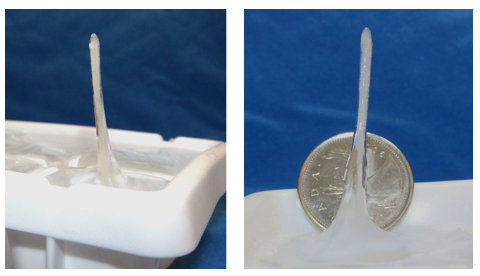Don Mercer
Our daughter’s freezer has been doing some rather strange things over the past year or so.
Whenever she makes ice cubes, one of them seems to produce a spike of ice that sticks up about two inches from the surface. No matter where she places the tray in the freezer, the same thing happens, and it’s not always the same ice cube in the tray that does it. The obvious explanation is that there is something “supernatural” going on, and her freezer is simply “possessed”.
Ice cubes with spikes are a great conversation piece, and it’s the privileged visitor to our daughter’s place who gets the “special” ice cube in his or her drink.
All kidding aside about supernatural phenomena in her freezer, there is actually a very good explanation for what is happening. Ice spikes have been observed in natural settings such as growing out of frozen birdbaths. There are accounts of ice spikes five feet high and the diameter of telephone poles rising out of the ice on the frozen waters of Lake Erie during the winter of 1963.
So, just what makes ice spikes happen?
When the ice cube tray is filled and placed in the freezer. The water cools first around the outer surfaces. This creates a thin sheet of ice across the top which traps the rest of the unfrozen water inside what is now an envelope of ice.
As the water inside the ice cube tray cools further and begins to freeze, it expands. This increases the pressure of the trapped water, and may cause the water to become super-cooled to a temperature below its normal freezing point. If there happens to be a small hole or weak spot in the ice on the top surface, the expanding water will force its way out through the hole and freeze as it leaves the surface of the ice cube.
Since the water freezes from the outside as it leaves the ice cube, there can be a hollow core within the rising column of ice. More water can travel up the inside causing the ice spike to continue growing. Eventually, the end of the ice spike may freeze over sufficiently to halt its growth.
Distilled water, or water with a low mineral content, works better than “hard” water containing higher levels of dissolved minerals such as calcium carbonate (i.e., limestone). This makes complete sense, since dissolved minerals can provide sites for ice crystals to begin forming, which reduces the chances of getting super-cooling of the water. There are also links between the temperature of the freezer and ice spike formation, as well as a dependency on the rate of freezing itself.
Freezers that are quite cold and freeze things rapidly don’t tend to form ice spikes in ice cubes as well as those which freeze the water more slowly. This may be due to the fact that the outer layer of the ice cube has become too strong for the trapped water to break through. In our freezer at home, all we see are lumps on the top of the ice cubes. These are totally uninteresting and definitely not worth getting excited about.
In the photos our daughter provided, you can see how the ice spike height is about twice the diameter of a quarter, and is quite slender.
Being a bit of a science geek, I’m somewhat envious of anyone who has a freezer capable of doing more than just making boring old ice cubes, with plain lumpy surfaces. Perhaps I’ll see if there is some way to help things along, and grow some ice spikes in our own freezer.

An ice spike growing out of an ice cube (Photos by Andrea Mercer)
Dr Don Mercer is Associate Professor in Food Science, Department of Food Science, University of Guelph, Guelph, Ontario N1G 2W1, Canada; e-mail: dmercer@uoguelph.ca
Permission to reproduce this article is greatly appreciated and acknowledged.
IUFoST Scientific Information Bulletin (SIB)
FOOD FRAUD PREVENTION